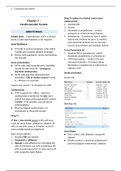Drug Tx options for rhythm control post-
Chapter 2 – cardioversion:
Cardiovascular System 1. Standard BB
2. Sotalol
3. Flecainide or propafenone – avoid in
ARRHYTHMIAS
ischaemic or structural heart disease
Ectopic beats – if spontaneous and in a normal 4. Amiodarone – if necessary, start 4 weeks
heart, Tx with beta-blockers is not required before and continue for up to 12 months
post-electrical cardioversion to increase
Atrial fibrillation
success of procedure and maintain rhythm
If Tx fails to control symptoms, refer within
Tx for Paroxysmal AF
4 weeks and consider ablation strategies
1. Standard BB or dronedarone, sotalol,
Review anticoagulation, stroke and bleeding
flecainide, propafenone or amiodarone
risk annually
2. ‘Pill-in-the-pocket’ – useful in Pts with
Acute presentation infrequent episodes. It involves taking
All Pts with fatal haemodynamic instability flecainide or propafenone to self-treat an
caused by new-onset AF = emergency episode of AF
electrical cardioversion
Stroke prevention
All Pts with non-fatal haemodynamic
instability = rate or rhythm control if onset Stroke risk:
is < 48 hours or uncertain
Urgent rate control = IV verapamil or a BB
Cardioversion
If AF is present for >48hrs – electrical
cardioversion is preferred. Do NOT start
until Pt has been anticoagulated for at least
3 weeks. If not possible, use parenteral
Bleeding risk:
anticoagulation
Pharmacological cardioversion = IV
amiodarone or flecainide acetate
Drug Tx
1st line = rate control except in Pts with new-
onset AF, atrial flutter suitable for ablation, AF
with a reversible cause or if rhythm control is
more suitable based on judgement
Atrial flutter
Rate control options: Rate control = BB, diltiazem, verapamil,
1. Standard BB (not sotalol) digoxin
2. Verapamil or diltiazem Rhythm control = electrical cardioversion,
3. Digoxin is only effective for controlling the pharmacological cardioversion, ablation
rate at rest hence use only in sedentary Pts
with non-paroxysmal AF. It’s also used in AF
with congestive heart failure
, 2 – Cardiovascular System
Paroxysmal supraventricular tachycardia arrhythmias or bradyarrhythmias unresponsive
Usually terminates spontaneously or with to atropine
reflex vagal stimulation like Valsalva
Digoxin – useful for controlling ventricular
manoeuvre, immersing face in cold water or
response in persistent and permanent AF
carotid sinus massage
Hypokalaemia predisposes Pt to digitalis
Arrythmias post MI toxicity – managed by K+ sparing diuretics
Treat bradycardia with atropine. If
unresponsive, treat with adrenaline/e BLEEDING DISORDERS
Ventricular tachycardia Tranexamic acid – impairs fibrin dissolution
Treat ASAP with immediate defibrillation Desmopressin – used in mild-to-mod
If stable – treat with anti-arrhythmics haemophilia and von Willebrand’s disease
Torsades de pointes – ventricular tachycardia Etamsylate – reduces capillary bleeding in the
associated with a long QT syndrome. presence of a normal number of platelets; it
Causes = drugs, hypokalaemia, severe doesn’t act by fibrin stabilisation
bradycardia and genetics.
Tx = magnesium sulfate, beta blocker (not VENOUS THROMBOEMBOLISM
sotalol) or atrial pacing
RFs = low mobility, obesity, malignant disease,
Avoid anti-arrhythmics (QT prolong risk)
H/O venous thromboembolism, thrombophilic,
Vaughn Williams classification of anti- pregnancy, post-partum, Pts aged >60 years
arrhythmics:
Mechanical prophylaxis: Stockings
- Class I = membrane stabilising drugs
Provide graduated compression and calf
(lidocaine, flecainide) pressure of 14-15mmHg.
- Class II = beta blockers Wear during day and night until mobile.
- Class III = amiodarone, sotalol Avoid in acute stroke and PAD
- Class IV = CCBs (not DHP CCBs)
Pharmacological prophylaxis
Negative ionotropic effect of anti-arrhythmics Start ASAP or within 14 hours of admission
can be additive. Hypokalaemia can enhance the RFs for bleeding = acute stroke, etc
arrhythmogenic effect of many drugs If bleeding risk, only receive
Supraventricular arrhythmias pharmacological prophylaxis if risk of VTE is
Adenosine = preferred Tx greater than risk of bleeding
Digoxin = slows ventricular response Surgical Pts
Verapamil = initial IV dose may be followed
by oral Tx. AVOID in AF in Wolff-Parkinson- Offer mechanical prophylaxis to Pts with
White syndrome and children major trauma or surgery. Continue until Pt
Beta blocker (e.g. esmolol, propranolol) – is mobile or discharged from hospital (or for
for rapid control of ventricular rate 30 days in spinal injury, spinal surgery or
cranial surgery)
Supraventricular and ventricular arrhythmias Offer pharmacological prophylaxis (LMWH,
Amiodarone – useful when another Tx fails. unfractionated heparin to Pts undergoing
It has a very long half-life. general or orthopaedic surgery
Digoxin-specific antibody – indicated for Tx of Pharmacological prophylaxis in general
digoxin toxicity associated with ventricular surgery should continue for at least 7 days
post-surgery or until mobile. Extend



